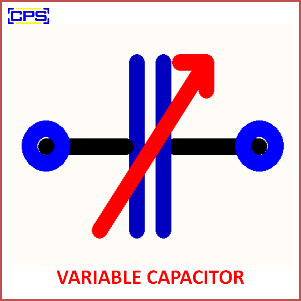A Variable Capacitor is a type of capacitor whose capacitance value can be adjusted manually or electronically. It consists of two conductive plates (or sets of plates) where the area of overlap, or the distance between them, can be varied to change the capacitance. This adjustment allows the capacitor to store different amounts of electrical charge at a given voltage, making it useful in applications that require tuning or precise control of capacitance.

Key Features of a Variable Capacitor:
- Adjustable Capacitance:
- The capacitance can be adjusted by altering the physical characteristics, such as the distance between the plates or the surface area of the plates.
- Mechanical or Electronic Control:
- Mechanical Adjustment: Typically, a knob or dial is used to rotate one of the plates, changing the capacitance.
- Electronic Adjustment: In some cases, the capacitance may be electronically controlled using a voltage or a digital signal.
- Structure:
- Usually consists of a set of fixed and movable plates (often made of metal) separated by an insulating material (dielectric).
- Frequency Tuning:
- Variable capacitors are often used in circuits where frequency tuning or resonance adjustments are required.
Working Principle:
- The capacitance CCC of a capacitor is given by the formula: C=εAdC = \frac{\varepsilon A}{d}C=dεA Where:
- ε\varepsilonε is the permittivity of the dielectric material.
- AAA is the area of overlap of the two plates.
- ddd is the distance between the plates.
By varying AAA (area of overlap) or ddd (distance between plates), the capacitance can be adjusted.
Applications of Variable Capacitors:
- Tuning Circuits:
- Commonly used in radio receivers, transmitters, and other frequency-selective circuits to adjust the resonant frequency.
- Oscillators:
- Used in oscillator circuits to set or control the frequency.
- Filters:
- In electronic filters, variable capacitors help tune the circuit for different frequencies.
- RF and Microwave Circuits:
- Employed in high-frequency circuits for applications such as communication systems, signal modulation, and more.
- Phase Shifters:
- Used in circuits that require phase control, such as in audio or signal processing.
Advantages:
- Precise Control: Provides the ability to finely adjust capacitance to optimize circuit performance.
- Tuning Flexibility: Essential in applications like radio tuning where continuous adjustment of capacitance is needed.
- Compact Size: Available in small sizes, which is suitable for portable electronic devices.
Disadvantages:
- Mechanical Wear: If the adjustment mechanism is mechanical, it may wear out over time.
- Limited Range: The capacitance range may be limited, depending on the design.
- Temperature Sensitivity: Some variable capacitors may be sensitive to temperature changes, which can affect their performance.
